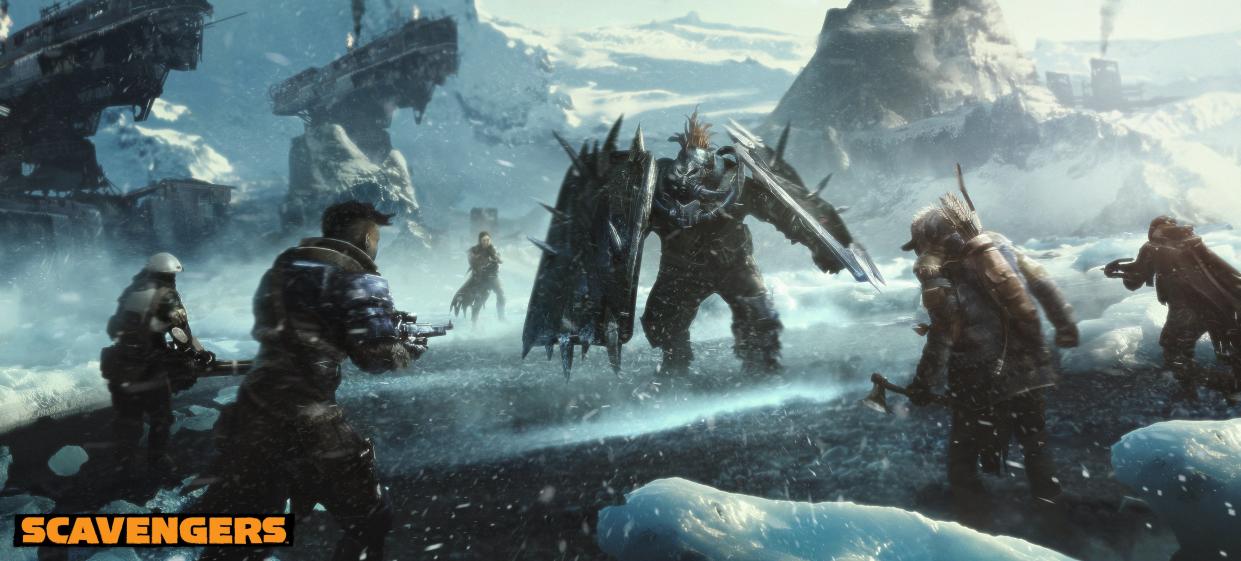‘Scavengers’ Has the Makings of a Possible Megahit

At first blush, Midwinter Entertainment’s “Scavengers” comes off as a calculated hybrid of all of the trends that have left bright streaks in their wake as they came and went over the past decade, from the carefully-delimited “heroes” of “Overwatch” to the nonstop resource Hoovering of “Fortnite.” But beneath its carefully-constructed facade lies a tangle of intricate systems that, if properly executed, could bring a new level of sophistication to the third-person shooter genre. That is, of course, if the teeming masses of “Apex” and “Fortnite” fans are interested in a game that turns more on finely-balanced tactical decisions and smart teamplay rather than twitch aim and positioning.
“Scavengers” belongs to a somewhat-thin crop of multiplayer games that bill themselves as a hybrid of “player vs. player” and “player vs. environment.” Four teams of three scavengers each compete to survive an inhospitable winter environment crawling with mangy wolves, hostile survivors, and skittering flesh-demons, all of which are controlled by A.I. Players must also grapple with ever-dwindling resource meters that will be familiar to any fan of survival games, including hunger, body heat, and a plague-like “virus” that the zombies can inflict. Even though these mechanics are fairly straightforward, the sheer number of them can prove a bit overwhelming at first, which makes “Scavengers” far from the pick-up-and-play experience of other games in its space. But once all its systems begin working in concert, the game’s wealth of potential begins to shine through.
Related stories
'Bayonetta 3' Development is 'Going Well' Despite E3 Absence
'Vader Immortal: Episode I' Hits Oculus Rift This Month
According to Midwinter’s studio head Josh Holmes, each match of “Scavengers” has three main phases. At first, the teams scout around and explore their environment, picking up necessities like food and basic weapons, battling low-level computer-controlled goons to claim their first foothold. Beyond that, each team engages in a sort of resource race to level-up their gear faster than their competitors, with armor and character-specific weapons locked behind “hides” dropped by hostile animals and weapon shards that you obtain by scrapping subpar weapons. As each team begins to master their environment, they gather “samples,” which bestow bonus points at the end of the game. After enough time passes, a dropship will descend to the icebound planet to collect you and send you back to your satellite home. If you manage to get onto the dropship, you “win” the match – regardless of how many samples you hold.
It’s a somewhat confusing concept for a game ostensibly about shooting people, but while the math is still in flux, Holmes says that Midwinter’s goal is to create interesting tactical dilemmas. Since the samples you collect during an individual match figure heavily into your overall progress as a player, Holmes says there’s a powerful incentive for aggressive players to ambush teams with depleted resources late in the game, in order to collect their samples. “There’s nothing that says that only one team can get onto the dropship safely,” he says. “In fact, if you have more people on it, you’ll get bonuses. But a team can get a lot more if they become aggressive and take out another team.”
It’s a fundamentally enthralling game concept, and not one that you see often in the red-and-blue world of team shooters. That said, given that so much of the game’s double-edged “co-opetition” relies on players caring more about their meta-currency than “winning” an individual match, it’s hard to know how tempting it could be without those systems in place. Which is exactly what happened in my guided match of the game: after what seemed like fairly standard first and second phases, we ended up getting into a harrowing three-team scrap in the center of an ice-storm as the dropship came down. Having narrowly defeated our foes, we didn’t even consider hunting down the final team for their samples, we sprinted to the dropship and took the easy win. For Holmes, such decisions will always come down to an individual’s preferred playstyle, which is a big part of why they wanted to make “Scavengers” in the first place.
“We really want to give people options,” Holmes says. “I love battle royale games, but they ultimately boil down to the same thing every time, hunting down your opponents. With ‘Scavengers,’ there really is the potential for matches to go very differently every time you play. Maybe you don’t even want to PvP at all, maybe you just want to take down the mobs and survive. You can definitely do that. We see it in playtesting all the time.”
While Scavengers is still fairly far from its launch at some point next year, Midwinter has already confirmed that it will be a free-to-play game, with monetization coming in the form of cosmetics and additional characters. The pitch sounds enticing, and the game shows well, but it’s hard to know how exactly a complex multiplayer game like “Scavengers” will fare in the cutthroat gaming climate of 2020. Personally, though, as a “battle royale” fan itching for a more sophisticated take on the core concept, I’m rooting for it.
Sign up for Variety’s Newsletter. For the latest news, follow us on Facebook, Twitter, and Instagram.

